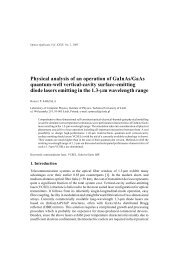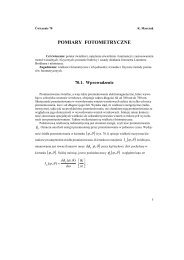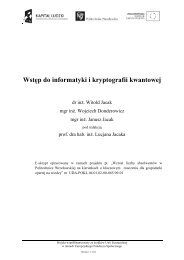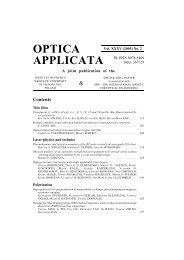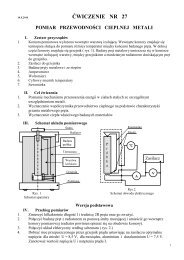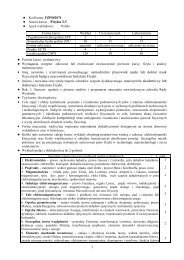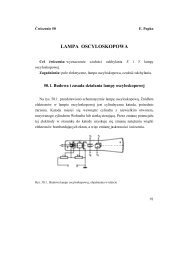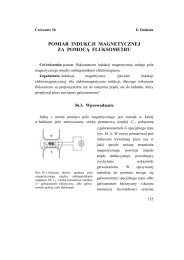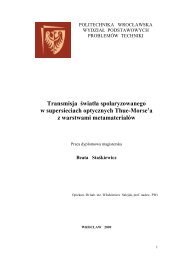Semiconductor device
Semiconductor device
Semiconductor device
Create successful ePaper yourself
Turn your PDF publications into a flip-book with our unique Google optimized e-Paper software.
<strong>Semiconductor</strong> <strong>device</strong><br />
From Wikipedia, the free encyclopedia<br />
http://en.wikipedia.org/wiki/<strong>Semiconductor</strong>_<strong>device</strong><br />
• Ten things you may not know about Wikipedia •<br />
For information on semiconductor physics, see semiconductor.<br />
<strong>Semiconductor</strong> <strong>device</strong>s are electronic components that exploit the electronic properties of<br />
semiconductor materials, principally silicon, germanium, and gallium arsenide.<br />
<strong>Semiconductor</strong> <strong>device</strong>s have replaced thermionic <strong>device</strong>s (vacuum tubes) in most<br />
applications. They use electronic conduction in the solid state as opposed to the gaseous state<br />
or thermionic emission in a high vacuum.<br />
<strong>Semiconductor</strong> <strong>device</strong>s are manufactured both as single discrete <strong>device</strong>s and as integrated<br />
circuits (ICs), which consist of a number—from a few to millions—of <strong>device</strong>s manufactured<br />
and interconnected on a single semiconductor substrate.<br />
Contents<br />
[hide]<br />
• 1 <strong>Semiconductor</strong> <strong>device</strong> fundamentals<br />
o 1.1 Diode<br />
o 1.2 Transistor<br />
• 2 <strong>Semiconductor</strong> <strong>device</strong> materials<br />
• 3 List of common semiconductor <strong>device</strong>s<br />
• 4 <strong>Semiconductor</strong> <strong>device</strong> applications<br />
o 4.1 Component identifiers<br />
• 5 History of semiconductor <strong>device</strong> development<br />
o 5.1 1900s<br />
o 5.2 World War II<br />
o 5.3 Development of the diode<br />
o 5.4 Development of the transistor<br />
o 5.5 The first transistor<br />
o 5.6 Origin of the term "transistor"<br />
o 5.7 Improvements in transistor design<br />
• 6 See also<br />
• 7 References<br />
• 8 Links<br />
[edit] <strong>Semiconductor</strong> <strong>device</strong> fundamentals<br />
The main reason why semiconductor materials are so useful is that the behaviour of a<br />
semiconductor can be easily manipulated by the addition of impurities, known as doping.<br />
<strong>Semiconductor</strong> conductivity can be controlled by introduction of an electric field, by exposure<br />
1
to light, and even pressure and heat; thus, semiconductors can make excellent sensors. Current<br />
conduction in a semiconductor occurs via mobile or "free" electrons and holes, collectively<br />
known as charge carriers. Doping a semiconductor such as silicon with a small amount of<br />
impurity atoms, such as phosphorus or boron, greatly increases the number of free electrons<br />
or holes within the semiconductor. When a doped semiconductor contains excess holes it is<br />
called "p-type", and when it contains excess free electrons it is known as "n-type", where p<br />
(positive for holes) or n (negative for electrons) is the sign of the charge of the majority<br />
mobile charge carriers. The semiconductor material used in <strong>device</strong>s is doped under highly<br />
controlled conditions in a fabrication facility, or fab, to precisely control the location and<br />
concentration of p- and n-type dopants. The junctions which form where n-type and p-type<br />
semiconductors join together are called p-n junctions.<br />
[edit] Diode<br />
The p-n junction diode is a <strong>device</strong> made from a p-n junction. At the junction of a p-type and<br />
an n-type semiconductor there forms a region called the depletion zone which blocks current<br />
conduction from the n-type region to the p-type region, but allows current to conduct from the<br />
p-type region to the n-type region. Thus when the <strong>device</strong> is forward biased, with the p-side at<br />
higher electric potential, the diode conducts current easily; but the current is very small when<br />
the diode is reverse biased.<br />
Exposing a semiconductor to light can generate electron–hole pairs, which increases the<br />
number of free carriers and its conductivity. Diodes optimized to take advantage of this<br />
phenomenon are known as photodiodes. Compound semiconductor diodes can also be used to<br />
generate light, as in light-emitting diodes and laser diodes.<br />
[edit] Transistor<br />
Two MOS transistors with common gate (metallic layers and dielectric removed for clarity).<br />
Bipolar junction transistors are formed from two p-n junctions, in either n-p-n or p-n-p<br />
configuration. The middle, or base, region between the junctions is typically very narrow. The<br />
other regions, and their associated terminals, are known as the emitter and the collector. A<br />
small current injected through the junction between the base and the emitter changes the<br />
properties of the base-collector junction so that it can conduct current even though it is reverse<br />
biased. This creates a much larger current between the collector and emitter, controlled by the<br />
base-emitter current.<br />
Another type of transistor, the field effect transistor operates on the principle that<br />
semiconductor conductivity can be increased or decreased by the presence of an electric field.<br />
An electric field can increase the number of free electrons and holes in a semiconductor,<br />
thereby changing its conductivity. The field may be applied by a reverse-biased p-n junction,<br />
2
forming a junction field effect transistor, or JFET; or by an electrode isolated from the bulk<br />
material by an oxide layer, forming a metal-oxide-semiconductor field effect transistor, or<br />
MOSFET.<br />
Cross-section through a MOS transistor (metallic layers and dielectric removed for clarity),<br />
foreground.<br />
The MOSFET is the most used semiconductor <strong>device</strong> today. The gate electrode is charged to<br />
produce an electric field that controls the conductivity of a "channel" between two terminals,<br />
called the source and drain. Depending on the type of carrier in the channel, the <strong>device</strong> may<br />
be an n-channel (for electrons) or a p-channel (for holes) MOSFET. Although the MOSFET<br />
is named in part for its "metal" gate, in modern <strong>device</strong>s polysilicon is typically used instead.<br />
[edit] <strong>Semiconductor</strong> <strong>device</strong> materials<br />
Main article: <strong>Semiconductor</strong> materials<br />
By far, silicon (Si) is the most widely used material in semiconductor <strong>device</strong>s. Its combination<br />
of low raw material cost, relatively simple processing, and a useful temperature range make it<br />
currently the best compromise among the various competing materials. Silicon used in<br />
semiconductor <strong>device</strong> manufacturing is currently fabricated into boules that are large enough<br />
in diameter to allow the production of 300 mm (12 in.) wafers.<br />
Germanium (Ge) was a widely used early semiconductor material but its thermal sensitivity<br />
makes it less useful than silicon. Today, germanium is often alloyed with silicon for use in<br />
very-high-speed SiGe <strong>device</strong>s; IBM is a major producer of such <strong>device</strong>s.<br />
Gallium arsenide (GaAs) is also widely used in high-speed <strong>device</strong>s but so far, it has been<br />
difficult to form large-diameter boules of this material, limiting the wafer diameter to sizes<br />
significantly smaller than silicon wafers thus making mass production of GaAs <strong>device</strong>s<br />
significantly more expensive than silicon.<br />
Other less common materials are also in use or under investigation.<br />
Silicon carbide (SiC) has found some application as the raw material for blue light-emitting<br />
diodes (LEDs) and is being investigated for use in semiconductor <strong>device</strong>s that could withstand<br />
very high operating temperatures and environments with the presence of significant levels of<br />
ionizing radiation. IMPATT diodes have also been fabricated from SiC.<br />
3
Various indium compounds (indium arsenide, indium antimonide, and indium phosphide) are<br />
also being used in LEDs and solid state laser diodes. Selenium sulfide is being studied in the<br />
manufacture of photovoltaic solar cells.<br />
[edit] List of common semiconductor <strong>device</strong>s<br />
This list is incomplete; you can help by expanding it.<br />
Two-terminal <strong>device</strong>s:<br />
• Avalanche diode (avalanche breakdown diode)<br />
• DIAC<br />
• Diode (rectifier diode)<br />
• Gunn diode<br />
• IMPATT diode<br />
• Laser diode<br />
• Light-emitting diode (LED)<br />
• Photocell<br />
• PIN diode<br />
• Schottky diode<br />
• Solar cell<br />
• Tunnel diode<br />
• VCSEL<br />
• VECSEL<br />
• Zener diode<br />
Three-terminal <strong>device</strong>s:<br />
• Bipolar transistor<br />
• Darlington transistor<br />
• Field effect transistor<br />
• IGBT (Insulated Gate Bipolar Transistor)<br />
• SCR (Silicon Controlled Rectifier)<br />
• Thyristor<br />
• Triac<br />
• Unijunction transistor<br />
Four-terminal <strong>device</strong>s:<br />
• Hall effect sensor (magnetic field sensor)<br />
Multi-terminal <strong>device</strong>s:<br />
• Charge-coupled <strong>device</strong> (CCD)<br />
• Microprocessor<br />
• Random Access Memory (RAM)<br />
• Read-only memory (ROM)<br />
[edit] <strong>Semiconductor</strong> <strong>device</strong> applications<br />
4
All transistor types can be used as the building blocks of logic gates, which are fundamental<br />
in the design of digital circuits. In digital circuits like microprocessors, transistors act as onoff<br />
switches; in the MOSFET, for instance, the voltage applied to the gate determines whether<br />
the switch is on or off.<br />
Transistors used for analog circuits do not act as on-off switches; rather, they respond to a<br />
continuous range of inputs with a continuous range of outputs. Common analog circuits<br />
include amplifiers and oscillators.<br />
Circuits that interface or translate between digital circuits and analog circuits are known as<br />
mixed-signal circuits.<br />
Power semiconductor <strong>device</strong>s are discrete <strong>device</strong>s or integrated circuits intended for high<br />
current or high voltage applications. Power integrated circuits combine IC technology with<br />
power semiconductor technology, these are sometimes referred to as "smart" power <strong>device</strong>s.<br />
Several companies specialize in manufacturing power semiconductors.<br />
[edit] Component identifiers<br />
The type designators of semiconductor <strong>device</strong>s are often manufacturer specific. Nevertheless,<br />
there have been attempts at creating standards for type codes, and a subset of <strong>device</strong>s follow<br />
those. For discrete <strong>device</strong>s, for example, there are three standards: JEDEC JESD370B in<br />
USA, Pro Electron in Europe and JIS in Japan.<br />
[edit] History of semiconductor <strong>device</strong> development<br />
[edit] 1900s<br />
This section does not cite any references or sources. (October 2007)<br />
Please help improve this section by adding citations to reliable sources. Unverifiable material may be<br />
challenged and removed.<br />
<strong>Semiconductor</strong>s had been used in the electronics field for some time before the invention of<br />
the transistor. Around the turn of the 20th century they were quite common as detectors in<br />
radios, used in a <strong>device</strong> called a "cat's whisker". These detectors were somewhat troublesome,<br />
however, requiring the operator to move a small tungsten filament (the whisker) around the<br />
surface of a galena (lead sulfide) or carborundum (silicon carbide) crystal until it suddenly<br />
started working. Then, over a period of a few hours or days, the cat's whisker would slowly<br />
stop working and the process would have to be repeated. At the time their operation was<br />
completely mysterious. After the introduction of the more reliable and amplified vacuum tube<br />
based radios, the cat's whisker systems quickly disappeared. The "cat's whisker" is a primitive<br />
example of a special type of diode still popular today, called a Schottky diode.<br />
[edit] World War II<br />
During World War II, radar research quickly pushed radar receivers to operate at ever higher<br />
frequencies and the traditional tube based radio receivers no longer worked well. The<br />
introduction of the cavity magnetron from Britain to the United States in 1940 during the<br />
Tizard Mission resulted in a pressing need for a practical high-frequency amplifier.<br />
5
On a whim, Russell Ohl of Bell Laboratories decided to try a cat's whisker. By this point they<br />
had not been in use for a number of years, and no one at the labs had one. After hunting one<br />
down at a used radio store in Manhattan, he found that it worked much better than tube-based<br />
systems.<br />
Ohl investigated why the cat's whisker functioned so well. He spent most of 1939 trying to<br />
grow more pure versions of the crystals. He soon found that with higher quality crystals their<br />
finicky behaviour went away, but so did their ability to operate as a radio detector. One day he<br />
found one of his purest crystals nevertheless worked well, and interestingly, it had a clearly<br />
visible crack near the middle. However as he moved about the room trying to test it, the<br />
detector would mysteriously work, and then stop again. After some study he found that the<br />
behaviour was controlled by the light in the room–more light caused more conductance in the<br />
crystal. He invited several other people to see this crystal, and Walter Brattain immediately<br />
realized there was some sort of junction at the crack.<br />
Further research cleared up the remaining mystery. The crystal had cracked because either<br />
side contained very slightly different amounts of the impurities Ohl could not remove–about<br />
0.2%. One side of the crystal had impurities that added extra electrons (the carriers of<br />
electrical current) and made it a "conductor". The other had impurities that wanted to bind to<br />
these electrons, making it (what he called) an "insulator". Because the two parts of the crystal<br />
were in contact with each other, the electrons could be pushed out of the conductive side<br />
which had extra electrons (soon to be known as the emitter) and replaced by new ones being<br />
provided (from a battery, for instance) where they would flow into the insulating portion and<br />
be collected by the whisker filament (named the collector). However, when the voltage was<br />
reversed the electrons being pushed into the collector would quickly fill up the "holes" (the<br />
electron-needy impurities), and conduction would stop almost instantly. This junction of the<br />
two crystals (or parts of one crystal) created a solid-state diode, and the concept soon became<br />
known as semiconduction. The mechanism of action when the diode is off has to do with the<br />
separation of charge carriers around the junction. This is called a "depletion region".<br />
[edit] Development of the diode<br />
Armed with the knowledge of how these new diodes worked, a vigorous effort began in order<br />
to learn how to build them on demand. Teams at Purdue University, Bell Labs, MIT, and the<br />
University of Chicago all joined forces to build better crystals. Within a year germanium<br />
production had been perfected to the point where military-grade diodes were being used in<br />
most radar sets.<br />
[edit] Development of the transistor<br />
After the war, William Shockley decided to attempt the building of a triode-like<br />
semiconductor <strong>device</strong>. He secured funding and lab space, and went to work on the problem<br />
with Brattain and John Bardeen.<br />
The key to the development of the transistor was the further understanding of the process of<br />
the electron mobility in a semiconductor. It was realized that if there was some way to control<br />
the flow of the electrons from the emitter to the collector of this newly discovered diode, one<br />
could build an amplifier. For instance, if you placed contacts on either side of a single type of<br />
crystal the current would not flow through it. However if a third contact could then "inject"<br />
electrons or holes into the material, the current would flow.<br />
6
Actually doing this appeared to be very difficult. If the crystal were of any reasonable size,<br />
the number of electrons (or holes) required to be injected would have to be very large -–<br />
making it less than useful as an amplifier because it would require a large injection current to<br />
start with. That said, the whole idea of the crystal diode was that the crystal itself could<br />
provide the electrons over a very small distance, the depletion region. The key appeared to be<br />
to place the input and output contacts very close together on the surface of the crystal on<br />
either side of this region.<br />
Brattain started working on building such a <strong>device</strong>, and tantalizing hints of amplification<br />
continued to appear as the team worked on the problem. Sometimes the system would work<br />
but then stop working unexpectedly. In one instance a non-working system started working<br />
when placed in water. Ohl and Brattain eventually developed a new branch of quantum<br />
mechanics known as surface physics to account for the behaviour. The electrons in any one<br />
piece of the crystal would migrate about due to nearby charges. Electrons in the emitters, or<br />
the "holes" in the collectors, would cluster at the surface of the crystal where they could find<br />
their opposite charge "floating around" in the air (or water). Yet they could be pushed away<br />
from the surface with the application of a small amount of charge from any other location on<br />
the crystal. Instead of needing a large supply of injected electrons, a very small number in the<br />
right place on the crystal would accomplish the same thing.<br />
Their understanding solved the problem of needing a very small control area to some degree.<br />
Instead of needing two separate semiconductors connected by a common, but tiny, region, a<br />
single larger surface would serve. The emitter and collector leads would both be placed very<br />
close together on the top, with the control lead placed on the base of the crystal. When current<br />
was applied to the "base" lead, the electrons or holes would be pushed out, across the block of<br />
semiconductor, and collect on the far surface. As long as the emitter and collector were very<br />
close together, this should allow enough electrons or holes between them to allow conduction<br />
to start.<br />
[edit] The first transistor<br />
A stylized replica of the first transistor<br />
The Bell team made many attempts to build such a system with various tools, but generally<br />
failed. Setups where the contacts were close enough were invariably as fragile as the original<br />
cat's whisker detectors had been, and would work briefly, if at all. Eventually they had a<br />
practical breakthrough. A piece of gold foil was glued to the edge of a plastic wedge, and then<br />
the foil was sliced with a razor at the tip of the triangle. The result was two very closely<br />
spaced contacts of gold. When the plastic was pushed down onto the surface of a crystal and<br />
voltage applied to the other side (on the base of the crystal), current started to flow from one<br />
7
contact to the other as the base voltage pushed the electrons away from the base towards the<br />
other side near the contacts. The point-contact transistor had been invented.<br />
While the <strong>device</strong> was constructed a week earlier, Brattain's notes describe the first<br />
demonstration to higher-ups at Bell Labs on the afternoon of 23 December 1947, often given<br />
as the birthdate of the transistor. The "PNP point-contact germanium transistor" operated as a<br />
speech amplifier with a power gain of 18 in that trial. Known generally as a point-contact<br />
transistor today, John Bardeen, Walter Houser Brattain, and William Bradford Shockley were<br />
awarded the Nobel Prize in physics for their work in 1956.<br />
[edit] Origin of the term "transistor"<br />
Bell Telephone Laboratories needed a generic name for their new invention: "<strong>Semiconductor</strong><br />
Triode", "Solid Triode", "Surface States Triode" [sic], "Crystal Triode" and "Iotatron" were<br />
all considered, but "transistor", coined by John R. Pierce, won an internal ballot. The rationale<br />
for the name is described in the following extract from the company's Technical Memoranda<br />
(May 28, 1948) [26] calling for votes:<br />
Transistor. This is an abbreviated combination of the words "transconductance" or "transfer",<br />
and "varistor". The <strong>device</strong> logically belongs in the varistor family, and has the<br />
transconductance or transfer impedance of a <strong>device</strong> having gain, so that this combination is<br />
descriptive.<br />
[edit] Improvements in transistor design<br />
Shockley was upset about the <strong>device</strong> being credited to Brattain and Bardeen, who he felt had<br />
built it "behind his back" to take the glory. Matters became worse when Bell Labs lawyers<br />
found that some of Shockley's own writings on the transistor were close enough to those of an<br />
earlier 1925 patent by Julius Edgar Lilienfeld that they thought it best that his name be left off<br />
the patent application.<br />
Shockley was incensed, and decided to demonstrate who was the real brains of the operation.<br />
Only a few months later he invented an entirely new type of transistor with a layer or<br />
'sandwich' structure. This new form was considerably more robust than the fragile pointcontact<br />
system, and would go on to be used for the vast majority of all transistors into the<br />
1960s. It would evolve into the bipolar junction transistor.<br />
With the fragility problems solved, a remaining problem was purity. Making germanium of<br />
the required purity was proving to be a serious problem, and limited the number of transistors<br />
that actually worked from a given batch of material. Germanium's sensitivity to temperature<br />
also limited its usefulness. Scientists theorized that silicon would be easier to fabricate, but<br />
few bothered to investigate this possibility. Gordon K. Teal was the first to develop a working<br />
silicon transistor, and his company, the nascent Texas Instruments, profited from its<br />
technological edge. Germanium disappeared from most transistors by the late 1960s.<br />
Within a few years, transistor-based products, most notably radios, were appearing on the<br />
market. A major improvement in manufacturing yield came when a chemist advised the<br />
companies fabricating semiconductors to use distilled water rather than tap water: calcium<br />
ions were the cause of the poor yields. "Zone melting", a technique using a moving band of<br />
molten material through the crystal, further increased the purity of the available crystals.<br />
8
[edit] See also<br />
Electronics Portal<br />
• Integrated circuit<br />
• VLSI<br />
• Category:<strong>Semiconductor</strong> <strong>device</strong> fabrication<br />
• DLTS<br />
[edit] References<br />
• Muller, Richard S., and Theodore I. Kamins (1986). Device Electronics for Integrated<br />
Circuits. John Wiley and Sons. ISBN 0-471-88758-7.<br />
[edit] Links<br />
<strong>Semiconductor</strong> Timeline Exhibit - Computer History Museum<br />
Retrieved from "http://en.wikipedia.org/wiki/<strong>Semiconductor</strong>_<strong>device</strong>"<br />
Categories: <strong>Semiconductor</strong> <strong>device</strong>s | <strong>Semiconductor</strong>s<br />
9




